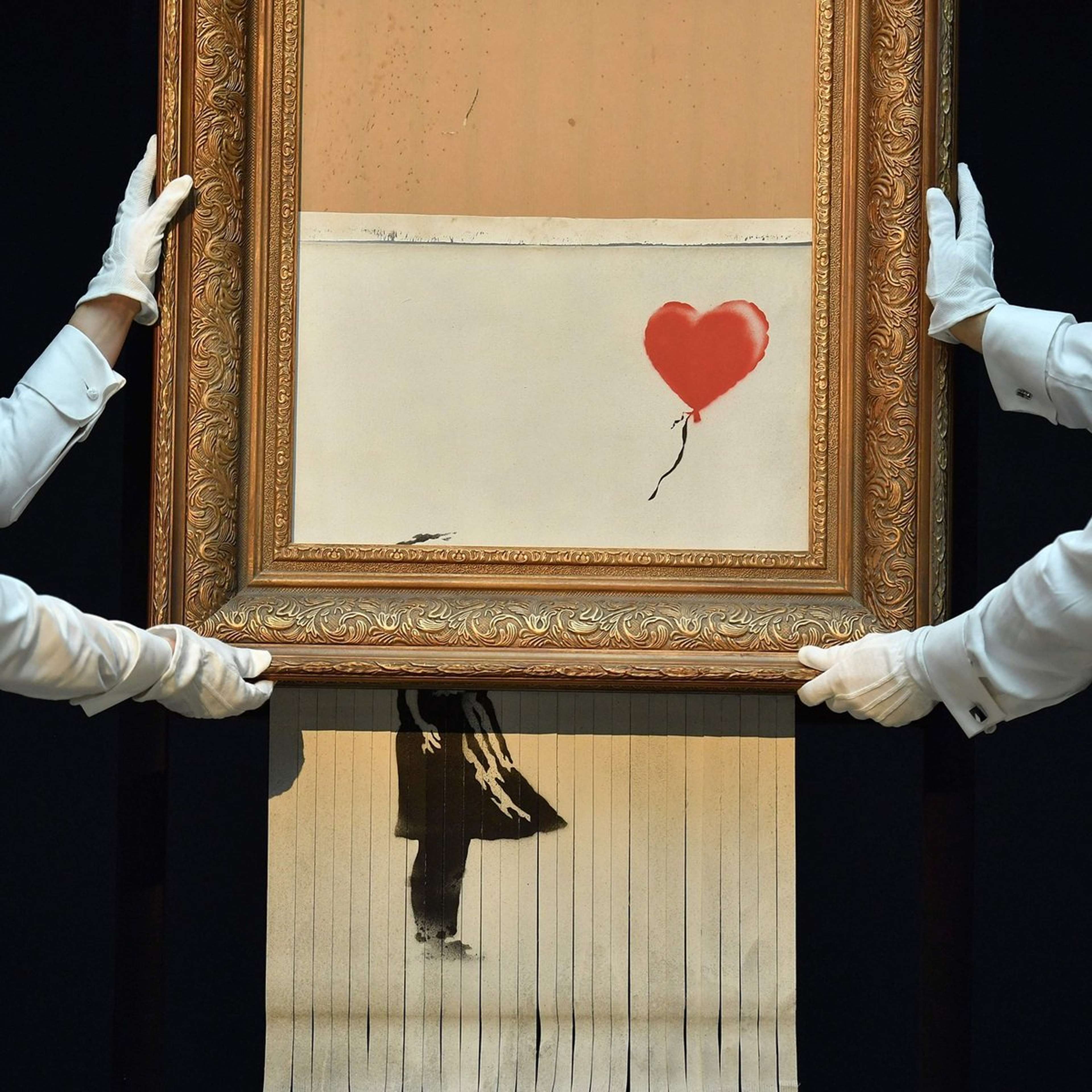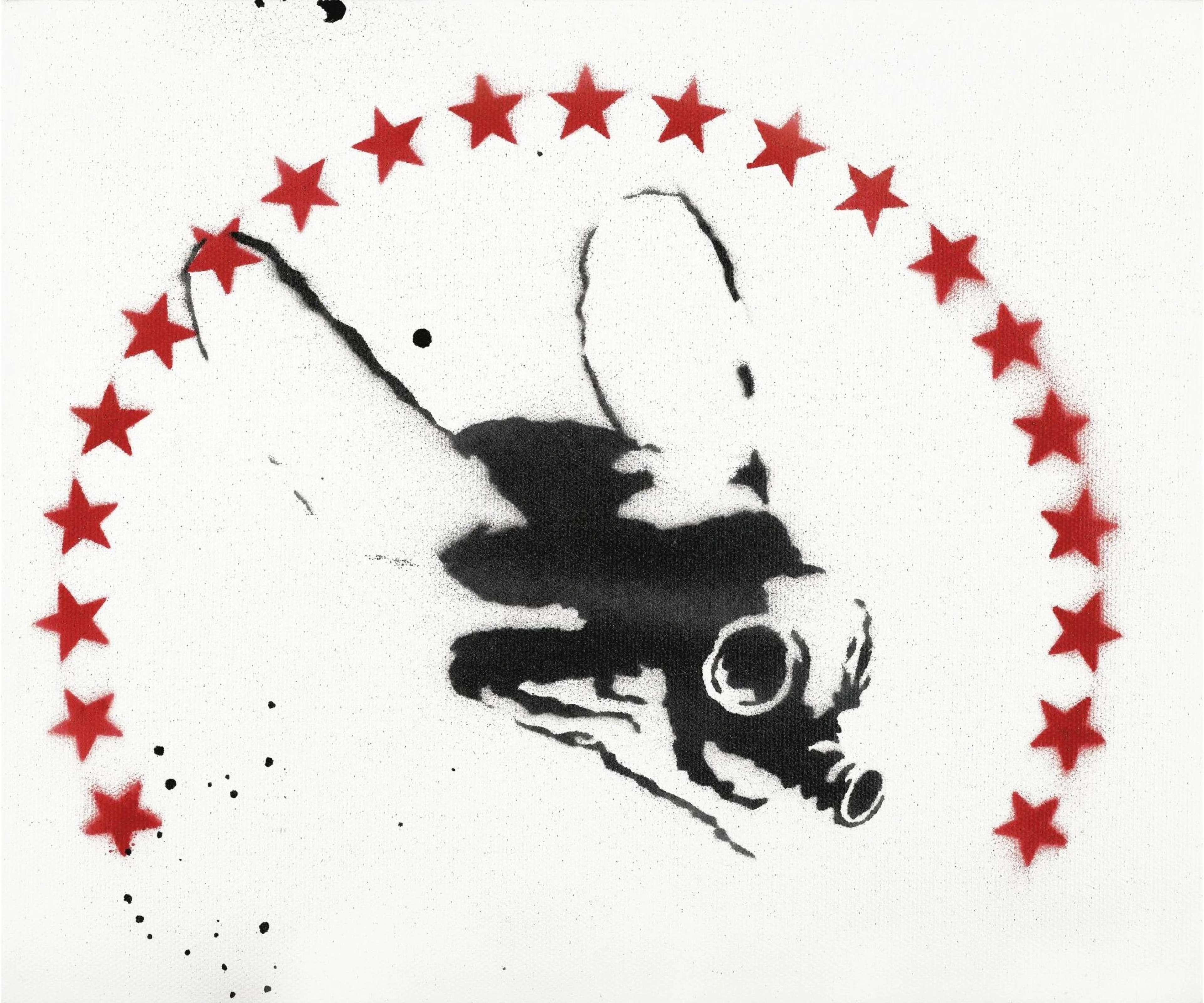Banksy’s Shredded Artwork, Love Is In The Bin, sells for record £18.6M

 Image © Sotheby's / Love Is In The Bin © Banksy 2021
Image © Sotheby's / Love Is In The Bin © Banksy 2021
Banksy
269 works
In October 2018, Banksy’s self-destructing Girl with Balloon left the art world torn with questions. How did he do it? Was Sotheby’s in on the stunt? Now, just three years later, Banksy's iconic Love Is In The Bin has made more headlines, having sold for a record-breaking £18,582,000 at Sotheby's Contemporary Art Evening Auction in London, more than triple its high estimate.
Around 2006 Banksy installed a secret, hidden shredder inside's frame. Seemingly fed up with the inflated price tags his work is given on the secondary market – which he does not profit from – Banksy installed a remote-controlled shredder featuring a row of scalpels inside the frame of a Girl with Balloon canvas, in case the piece ever went to auction. The ornate gilt frame is itself a nod to the elitist traditions of the art world. Banksy gave the framed canvas to a friend after his now-famous Barely Legal exhibition in Los Angeles in 2006, suggesting he installed the shredder before or shortly after the show.
OCTOBER 2018: Banksy creates anti establishment art live at Sotheby's
On the memorable night, 5th October 2018, Banksy's Girl with Balloon was the last artwork to be sold at Sotheby's Contemporary Art Evening Auction. Estimated at £200,000-300,000, the artwork eventually realised £1.04million with fees.
Once the hammer fell on the successful bid, the work began sliding out of the bottom of the frame and came out the other side in shreds, to the sound of a siren and gasps from the audience. The painting stopped when it was around halfway through the shredder, leaving the top intact. Speaking to the press after the sale, Sotheby's Senior Director Alex Branczik famously commented “It appears we just got Banksy-ed”. The auction house proceeded to describe the shredded Banksy as “the first artwork in history to have been created live during an auction” and informed the world of the work's new title, Love Is In The Bin.
According to a now-deleted video Banksy posted on his Instagram after the event, the artwork did not shred how it was meant to. Banksy implied that the artwork was intended to self-destruct completely, stating “in rehearsals it worked every time”. The video was accompanied by a quote from Picasso that read, “The urge to destroy is also a creative urge”.
Also via an Instagram post, Banksy confirmed the renaming of the shredded Girl With a Balloon to Love is in the Bin, to reflect the fact that it is considered a new artwork by the artist. This move both confirms and marks the curtain-fall of Banksy's elaborately planned prank, the spectacular moment of shredding. Presumably, Banksy's authentication body, Pest Control, will have issued the buyer a new certificate, verifying it's authenticity under the new title.
What is the meaning behind Love is in the Bin? Why did Banksy shred his own artwork?
Banksy's work has long been in tension with the art world, poking fun at its astronomical prices and exclusivity – this can be seen in works such as his 2006 Morons print, which shows an auctioneer selling a canvas emblazoned with the words ‘I can't believe you morons actually buy this shit'. That Banksy installed his custom shredding mechanism inside the frame of a Girl With Balloon print at around the same time as he created Morons gives us a large clue as to his motive.
While Banksy is known for enjoying a prank, or for luring the media to his advantage, the stunt can hardly be classified as a cheap media ploy; 12 years in advance, Banksy planned to further compound his critique, as found in Morons, of the strange logic and wealth of the commercial art world.
The new artwork's creation will go down in history as one of the most famous examples of performance art in contemporary history. The stunt has its precedents in defiantly anti establishment modern art, such as Marcel Duchamp's infamous Fountain, which shares a similarly disdainful attitude towards the art market and its elite demographic. As a popular artist with an outreach spreading well beyond the art-world elite (for example, as he was voted the UK's favourite artist in 2019) to create such conceptual art is a bold move in favour of modern art's legacy, which has often been viewed by the general public as unrelatable and overly intellectual.
Who bought Banksy's shredded artwork?
Even though the artwork she originally bid on was destroyed, the anonymous female buyer, European collector and long-standing Sotheby's client, decided to proceed with the sale: “When the hammer came down last week and the work was shredded, I was at first shocked, but gradually I began to realise that I would end up with my own piece of art history,” she said.
Subsequent to the eventful sale, the work went on public display at Sotheby's and Frieder Burda de Baden-Baden Museum in South West Germany, who “deactivated” the internal shredder to avoid a visitor accidentally setting it off. After this, the owner of Love Is In The Bin generously placed the artwork on long-term loan at the Staatsgalerie Stuttgart Museum, allowing Banksy fans to get a first hand look at the new artwork.
Love Is In The Bin goes down in contemporary art history
The stunt gained many column inches as commentators rushed to put in their two cents on the event, including dealer and columnist for Artnet, Kenny Schacter, who wrote, “In a realm as chockablock with legerdemain as the art world, what matters, at the end of the day, is that the audience enjoyed the show. With his star turn at Sotheby's, Banksy gave us all a command performance.”
Many art world commentators also speculated that the piece had risen in value significantly after such a public stunt. MyArtBroker's lead Banksy broker Joe Syer was quoted in The Guardian saying: “The auction result will only propel this further and given the media attention this stunt has received, the lucky buyer would see a great return on the £1.02m they paid last night. This is now part of art history in its shredded state and we'd estimate Banksy has added at a minimum 50% to its value.”
Testimony to the ripples Banksy had created, the news was picked up by numerous news outlets, including BBC news, The Telegraph and BBC TV programme Have I Got News For You.
Was Sotheby's in on the Love Is In The Bin stunt?
“Were we in on it? Absolutely not,” Branczik has stated. But many have speculated that the auction house was in fact in on the trick, claiming that it would have been impossible not to notice the weight and bulk of the inbuilt, hidden shredder in the frame, which was so ridiculously oversized to begin with. However, this has been countered by those saying that Pest Control, who were called in to authenticate the work, insisted that it could not be removed without causing damage to the artwork itself so the specialists could not investigate further.
Another clue is the fact that the painting was the last thing to be auctioned that night, providing the perfect headline act. Some have said this proves Sotheby's collusion – if it had been placed in the middle of the auction it would have caused too much confusion and distraction from the rest of the works on sale. However, this too cannot be confirmed, with insiders saying that the painting was placed last because of annoyance with the consignor (thought to be Banksy himself, using a third party for the process) who had insisted on having the piece in the evening sale, when it should have been in the day sale. As a result, it was put in the last slot, one of the least favourable in terms of the running order of an auction.
Finally, the nail in the coffin of this theory comes from a statement by Banksy's former gallerist and collaborator Steve Lazarides who said: “I worked for him for 12 years, the idea of him colluding with an institution to pull off a stunt is the complete antithesis to his philosophy.”
 Image © Sotheby's / Love Is In The Bin © Banksy 2021
Image © Sotheby's / Love Is In The Bin © Banksy 2021OCTOBER 2021: Love Is In The Bin's returns to Sotheby's auction
In early September, Sotheby's announced the return of Banksy's Love Is In The Bin to their Contemporary Art Evening Auction in London, scheduled for 14 October 2021. The auction house estimated that the artwork will sell for £4-6 million, suggesting it has quadrupled its value or more in just over three years.
Sotheby's stirred up attraction among Asian and American buyers again for Love Is In The Bin by exhibiting the artwork in Hong Kong, Taipei and New York before the sale. On the night of Sotheby's prestigious Evening Auction, presiding auctioneer Oliver Barker also stirred the crowd up, introducing the work with the bold (and equally undeniable) statement that "Today, this piece is considered heir to a venerated legacy of anti-establishment art... the ultimate Banksy artwork...".
How much did Love is in the Bin Sell for in 2021?
Ultimately, Love Is In The Bin sold for an astounding £18,582,000, more than tripling its presale high estimate of £6 million, and setting a new auction record for a Banksy. This week, when the anonymous buyer of Banksy's shredded Girl With A Balloon brought it back to auction at Sotheby's, nine people bid for more than 10 minutes, evidently eager to lay claim to the headline-maker. That price represents a 16-fold return for the previous owner, who bought the work for just over £1 million at the famed 2018 auction.
With this sale, Love Is In The Bin has topped the ranks of Banksy's most expensive artworks ever, beating Banksy’s Game Changer painting, which raised £16.8 million for the NHS earlier in 2021, when it was sold at Christie’s 20th Century Art Evening Sale in London on 23 March 2021, exactly one year after the UK’s first national lockdown. The price of the painting started at £1.6 million and skyrocketed as the 15-minute bidding battle unfolded, with the work eventually selling for almost seven times its £2.5 million low estimate.
Who bought Banksy's Love is in the Bin in 2021?
The successful bidder was a collector in Asia, the auction house said, evidencing both the success of Sotheby's publicity drive there and the continued growth of the Eastern art market's appetite for works by contemporary celebrity artists.
Finally, please don’t shred a Banksy print at home...
After reading the speculations that Banksy’s shredding increased the price of his work, one collector decided to shred his own unsigned Girl With Balloon print in hopes of adding value. It backfired disastrously.
Read more in Darwin Alert! – Someone’s Just Shredded A £40k Banksy Print.







